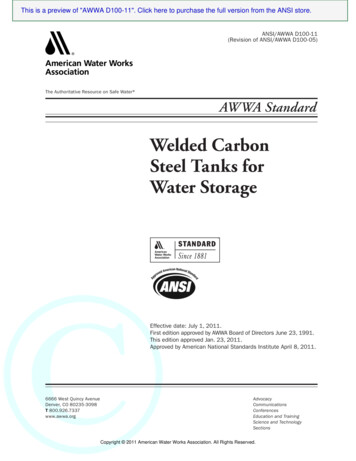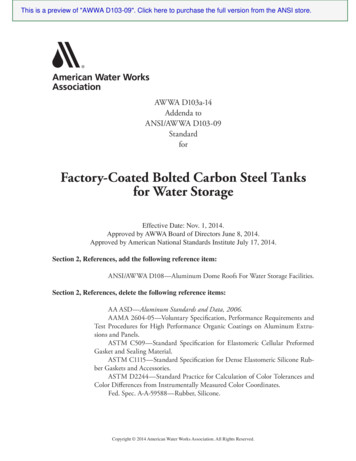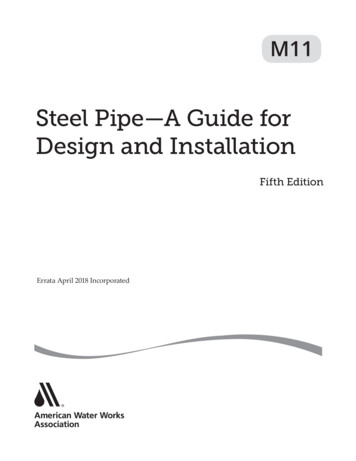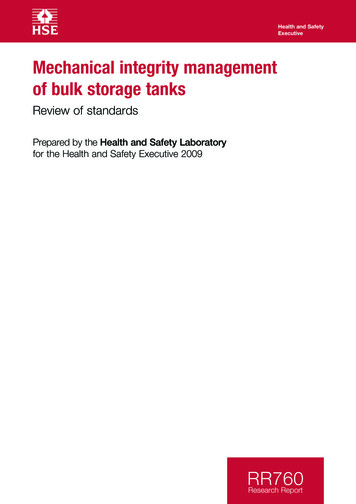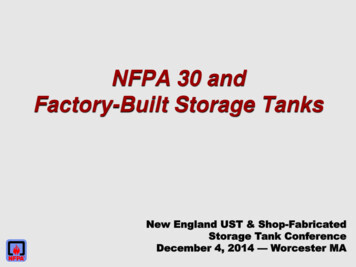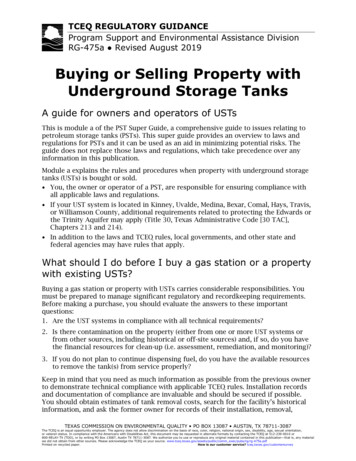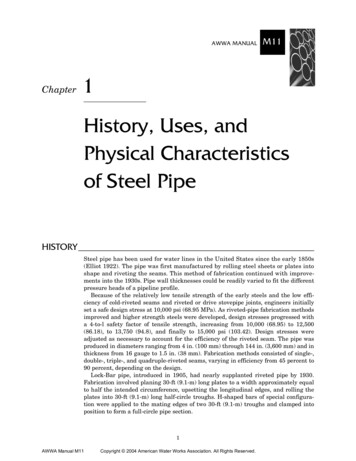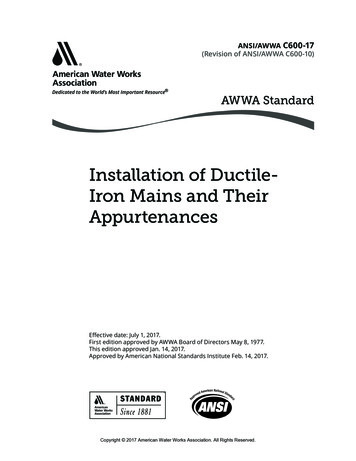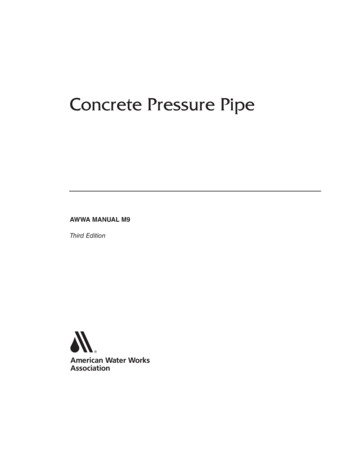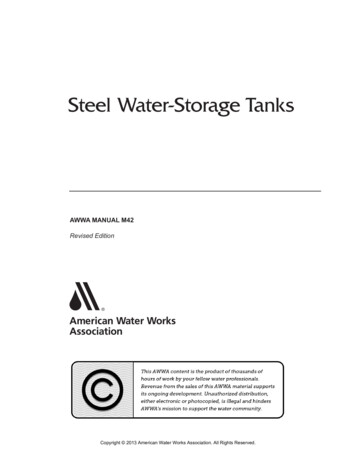
Transcription
Steel Water-Storage TanksAWWA MANUAL M42Revised EditionCopyright 2013 American Water Works Association. All Rights Reserved.
ContentsList of Figures, viiList of Tables, xiPreface, xiiiAcknowledgments, xvIntroduction, xviiDefinitions, xviiiAWWA Standards, xviiiWelded Tanks, xixBolted Tanks, xxComposite Elevated Tanks, xxPart I Elements of Steel Water Tanks 1Chapter 1 Typical Capacities and Configurations. . . . . . . . . . . . . . . . . . . . . . 3Reservoirs, 3Standpipes, 3Roof Designs for Reservoirs and Standpipes, 10Elevated Tanks, 12Multiple-Column Elevated Tanks, 13Pedestal Elevated Tanks, 18Chapter 2 Appurtenances. . . . . . . . . . . . . . . . . . . . . . . . . . . . . . . . . . . . . . . . . . 29Shell Manholes, 29Pipe Connections, 30Overflow, 32Ladders and Safety Devices, 33Roof Openings, 36Vents, 37Devices for Indicating Water Level, 39Emergency Fill/Withdraw Connections, 40Chapter 3 Cathodic Protection. . . . . . . . . . . . . . . . . . . . . . . . . . . . . . . . . . . . . . 41Nature of Corrosion, 41Principles of Cathodic Protection, 43Cathodic Protection Design, 44Maintenance, 45Chapter 4 Coating Systems. . . . . . . . . . . . . . . . . . . . . . . . . . . . . . . . . . . . . . . . . 49Interior Coatings, 49Exterior Coatings, 51Inspection and Quality Control, 52Removing Coating by Abrasive Blasting, 52iiiCopyright 2013 American Water Works Association. All Rights Reserved.
Part II The New Tank Project 55Chapter 5 Selecting and Sizing Water-Storage Tanks. . . . . . . . . . . . . . . . . . 57Peak Demand, 57Fire Flow, 58Top and Bottom Capacity Levels, 58Water Quality Issues, 58Energy Costs, 60Future Needs, 60Environmental Impact, 60Tank Costs, 60Chapter 6 Construction Considerations . . . . . . . . . . . . . . . . . . . . . . . . . . . . . 63Design Standards, 63Contract Documents, 64Constructor Capabilities, 64Guarantees, 64Soil Investigations, 64Reservoir and Standpipe Foundations, 67Elevated Tank Foundations, 69Tank Site, 69Tank Coating: Welded Steel Tanks, 71Tank Coating: Bolted Steel Tanks, 73Tank Water Testing and Disinfection, 73Engineer’s Role, 73Bidding Documents, 74Chapter 7 Inspecting New Tank Construction. . . . . . . . . . . . . . . . . . . . . . . . 77Responsibility for Quality, 77The Foundation, 78Fabrication, 80Steel Delivery, 80Tank Erection, 80Field Cleaning and Coating, 83Mechanical and Electrical Appurtenances, 85Part III Existing Tanks 87Chapter 8 Routine Operation and Maintenance. . . . . . . . . . . . . . . . . . . . . . 89Energy Management, 89Controls, 90Periodic Operator Inspection, 90Tank Washouts, 92Chapter 9 Professional Examination and Renovation . . . . . . . . . . . . . . . . . 95Tank Maintenance Engineer’s Functions and Qualifications, 96Pre-Bid Inspection, 98Preparing Specifications, 103Monitoring the Constructor’s Progress, 105Periodic Reinspection, 108ivCopyright 2013 American Water Works Association. All Rights Reserved.
Chapter 10 Cold-Weather Operation. . . . . . . . . . . . . . . . . . . . . . . . . . . . . . . 109Causes and Results of Freezing, 109Data Related to Freezing, 112Designing Tanks for Cold Weather, 112Cold-Weather Operating Procedures, 117Systems to Prevent Freezing, 119Dealing With Frozen Tanks, 121Appendix A Bibliography . . . . . . . . . . . . . . . . . . . . . . . . . . . . . . . . . . . . . . . . 123Appendix B Steel Water Tank Industry Standards . . . . . . . . . . . . . . . . . 125Appendix C ANSI/AWWA D101-53 (R86), Inspecting and Repairing SteelWater Tanks, Standpipes, Reservoirs, and Elevated Tanksfor Water Storage. . . . . . . . . . . . . . . . . . . . . . . . . . . . . . . . . . . . 131Index 141AWWA List of Manuals 147vCopyright 2013 American Water Works Association. All Rights Reserved.
IntroductionMore than 100,000 steel water-storage tanks have been constructed within thelast 100 years, a value that far exceeds the number of large water-storage vessels ofany other type of construction material. Many steel water tanks have service historiesin excess of a century and are still in service today (Figure F-1). Whereas early tankswere riveted, modern practice uses welded or bolted design and construction, whichprovide the advantage of a zero leakage tolerance.To further increase their potential service life, steel tanks can be dismantledand re-erected in new locations. A tank that was originally in an optimal location canbecome useless if a factory relocates or there is a shift in housing patterns. However, asteel tank can be dismantled and then erected and coated at a new location.This manual provides information on the selection, design, construction,maintenance, inspection, and repair of steel tanks for potable water storage. Themanual will assist in tank sizing, configuration, site selection, design, operation,and maintenance.Source: Tank Industry Consultants Inc.Figure F-1 A tank constructed in 1902 is still serving Wabash, Ind., withpractically no metal lossxviiCopyright 2013 American Water Works Association. All Rights Reserved.
DEFINITIONSThe following definitions apply in this manual:Bottom capacity level (BCL) The water level in the tank when the tank isemptied through the specified discharge fittings (unless otherwise specified by the purchaser). In an elevated tank, the elevation of the bottom capacity level(s) is as givenby the purchaser and is determined by the design features of the tank configuration.Capacity The net volume in gallons (liters) that may be removed from a tankemptied to its bottom capacity level after being filled to its top capacity level.Constructor The party that furnishes the work and materials for placementand installation.Elevated tank A container or storage tank supported on one or more columns.Engineer An employee of the purchaser or, more commonly, a professional engineering firm engaged by the purchaser to perform specification and inspection services.Head range The difference between the lower and upper capacity levels of atank.Manufacturer The person or company that furnishes the tank components.Owner The person or firm that will own and operate the completed tank. Theowner may designate agents, such as an engineer, purchaser, or inspector, for specificproject responsibilities.Purchaser The person, company, or organization that purchases the tank.Reservoir A ground-supported, flat-bottom cylindrical tank with a shell heightless than or equal to its diameter.Standpipe A ground-supported, flat-bottom cylindrical tank with a shellheight greater than its diameter.Tank An elevated tank, standpipe, or reservoir used for water storage.Top capacity level (TCL) The maximum operating level of water in a tank, asdictated by the elevation at which water discharges from the tank through the overflow pipe entrance. In a standpipe or reservoir, the top capacity level is as given by thepurchaser. In an elevated tank, the elevation of the top and/or bottom capacity level(s)is as given by the purchaser.AWWA STANDARDSThe majority of all steel potable water-storage tanks constructed in the UnitedStates adhere to specifications that reference the following American Water WorksAssociation (AWWA) steel tank standards: ANSI/AWWA D100, Standard for Welded Carbon Steel Tanks for WaterStorage. ANSI/AWWA D102, Standard for Coating Steel Water-Storage Tanks. ANSI/AWWA D103, Standard for Factory-Coated Bolted Carbon SteelTanks for Water Storage. ANSI/AWWA D104, Standard for Automatically Controlled, ImpressedCurrent Cathodic Protection for the Interior Submerged Surfaces of SteelWater Storage Tanks. ANSI/AWWA D106, Standard for Sacrificial Anode Cathodic ProtectionSystems for the Interior Submerged Surfaces of Steel Water Storage Tanks.xviiiCopyright 2013 American Water Works Association. All Rights Reserved.
ANSI/AWWA D107, Standard for Composite Elevated Tanks for WaterStorage. ANSI/AWWA D108, Standard for Aluminum Dome Roofs for Water StorageFacilities. ANSI/AWWA C652, Standard for Disinfection of Water-Storage Facilities.These standards (except ANSI/AWWA C652) are developed and maintainedunder the direction of the AWWA Standards Committee on Steel Elevated Tanks,Standpipes, and Reservoirs, which is composed of members representing consumer(utility), general interest (academic and consulting engineering), and producer (constructor and manufacturer) groups. ANSI/AWWA C652 was developed and is maintained by the AWWA Standards Committee on Disinfection of Facilities.Once a draft standard or revision is approved by a standards committee, it isforwarded to the AWWA Standards Council for review and approval. If approved bythe council, it is offered for public review and then presented to the AWWA Board ofDirectors for final approval. The standards listed above have also been approved asstandards by the American National Standards Institute (ANSI). AWWA D101-53(R86), Standard for Inspecting and Repairing Steel Water Tanks, Standpipes, Reservoirs, and Elevated Tanks for Water Storage (included here as appendix C), was withdrawn upon publication of the first edition of this manual in 1998.WELDED TANKSWelded tanks have been used for water storage since the 1930s. Welded construction had totally replaced riveted construction by the 1950s. This 20-year transitionperiod from riveted to welded design and construction was necessary because timewas needed to train enough skilled welders and because contractors wanted to keeptheir skilled riveting crews working as long as possible. Today, design and construction of welded tanks are usually performed under the guidelines of ANSI/AWWA D100.This standard was first published in the November 1935 edition of Journal - AmericanWater Works Association as “Standard Specifications for Riveted Steel Tanks andStandpipes” and has undergone several revisions since then.AdvantagesThe advent of welded tanks provided opportunities for new tank configurations, butthe greatest advantage of welded over riveted tanks was the development of smoothstructures with much lower maintenance costs than was possible with lapped, rivetedseams. Manual, semiautomatic, and automatic welding processes have improved continually over the years, offering increased economy and strength.Thicknesses and CapacitiesThicknesses of welded tank shells vary from 3/16 in. (4.76 mm) to 2 in. (50 mm) or more.As of the writing of this manual, the largest welded steel water-storage tank constructed had a capacity of 34 mil gal (130 ML). Elevated tanks have been constructedwith capacities up to 4 mil gal (15 ML), and designs are available for greater capacities.xixCopyright 2013 American Water Works Association. All Rights Reserved.
BOLTED TANKSFactory-coated bolted steel storage tanks were developed in the early 1900s to serveas crude-oil and brine containment vessels. In the late 1970s, this tank design gainedacceptance for potable water containment through the release of ANSI/AWWA D103,which allows the use of lighter-gauge steel in the production of tank sheets.ConstructionBolted steel tanks are made of uniformly sized panels (usually 5 ft wide by 8 ft highor 9 ft wide by 5 ft high [1.5 m 2.4 m or 2.7 m 1.5 m]), which can be readily transported and assembled at the tank site. Organic gaskets or sealants are used to achievea watertight seal at the bolted joints. Thicknesses of bolted tank panels vary from aminimum of 0.073 in. (1.85 mm) to 0.500 in. (12.7 mm). Since the panels are boltedtogether, the tanks can be dismantled and relocated with relative ease.CapacitiesBolted tanks are currently offered in incremental sizes depending on the tank manufacturer’s panel size. Capacities offered range from 4,000 gal (15,000 L) to approximately 2.5 mil gal (6.8 ML). Bolted tanks are available in reservoir and standpipeconfigurations. Maximum tank heights and capacities are limited by the manufacturer’s steel fabrication facility, as well as by ANSI/AWWA D103.Coating and Life of TankBolted tanks are factory coated for long-term corrosion protection. Four coating systems are presently available for bolted tanks: galvanized, glass, thermoset liquid suspension epoxy, and thermoset powder epoxy. According to the foreword of ANSI/AWWAD103, the anticipated life of a bolted tank is usually limited by the effective life of theprotective coating and cathodic protection system. If the coatings are not abused ordamaged, the anticipated life expectancy of bolted tanks is more than 30 years.COMPOSITE ELEVATED TANKSComposite elevated tanks have been used for water storage since the 1970s, with hundreds of tanks of this style having been constructed and placed into service before theissuance of an AWWA standard. Today the design and construction of composite elevated welded tanks are performed under the guidelines of ANSI/AWWA D107, whichwas issued in 2010.NOTE: The scope of ANSI/AWWA D107 is specific to “composite elevated tanksthat use a welded steel tank for watertight containment” (emphasis added). As of thepublication of this edition of Manual M42, no national standard exists that providesguidance on the design, construction, inspection, and testing of composite elevatedtanks that use a bolted steel tank for watertight containment.ConstructionThe composite elevated water tank consists of a concrete support structure (pedestal)and a welded or bolted steel tank. A variety of different styles of pedestal construction are employed by tank fabricators. The top of the pedestal may be constructed witheither a concave, convex, or flat top. A welded steel liner is placed over the concretepedestal top and serves as the floor of the welded steel tank. Bolted tanks may be furnished with a concrete or bolted steel floor.xxCopyright 2013 American Water Works Association. All Rights Reserved.
AWWA STANDARDS _ The majority of all steel potable water-storage tanks constructed in the United States adhere to specifications that reference the following American Water Works Association (AWWA) steel tank standards: ANSI/AWWA D100, Standard for Welded Carbon Steel Tanks for Water Storage. ANSI/AWWA D102, Standard for Coating Steel Water-Storage Tanks. ANSI/AWWA D103 .File Size: 668KBPage Count: 8
